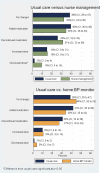Nurse-led disease management for hypertension control in a diverse urban community: a randomized trial
- PMID: 22143452
- PMCID: PMC3358388
- DOI: 10.1007/s11606-011-1924-1
Nurse-led disease management for hypertension control in a diverse urban community: a randomized trial
Abstract
Background: Treated but uncontrolled hypertension is highly prevalent in African American and Hispanic communities.
Objective: To test the effectiveness on blood pressure of home blood pressure monitors alone or in combination with follow-up by a nurse manager.
Design: Randomized controlled effectiveness trial.
Patients: Four hundred and sixteen African American or Hispanic patients with a history of uncontrolled hypertension. Patients with blood pressure ≥150/95, or ≥140/85 for patients with diabetes or renal disease, at enrollment were recruited from one community clinic and four hospital outpatient clinics in East and Central Harlem, New York City.
Intervention: Patients were randomized to receive usual care or a home blood pressure monitor plus one in-person counseling session and 9 months of telephone follow-up with a registered nurse. During the trial, the home monitor alone arm was added.
Main measures: Change in systolic and diastolic blood pressure at 9 and 18 months.
Key results: Changes from baseline to 9 months in systolic blood pressure relative to usual care was -7.0 mm Hg (Confidence Interval [CI], -13.4 to -0.6) in the nurse management plus home blood pressure monitor arm, and +1.1 mm Hg (95% CI, -5.5 to 7.8) in the home blood pressure monitor only arm. No statistically significant differences in systolic blood pressure were observed among treatment arms at 18 months. No statistically significant improvements in diastolic blood pressure were found across treatment arms at 9 or 18 months. Changes in prescribing practices did not explain the decrease in blood pressure in the nurse management arm.
Conclusions: A nurse management intervention combining an in-person visit, periodic phone calls, and home blood pressure monitoring over 9 months was associated with a statistically significant reduction in systolic, but not diastolic, blood pressure compared to usual care in a high risk population. Home blood pressure monitoring alone was no more effective than usual care.
Figures



References
Publication types
MeSH terms
Substances
Grants and funding
LinkOut - more resources
Full Text Sources
Medical

